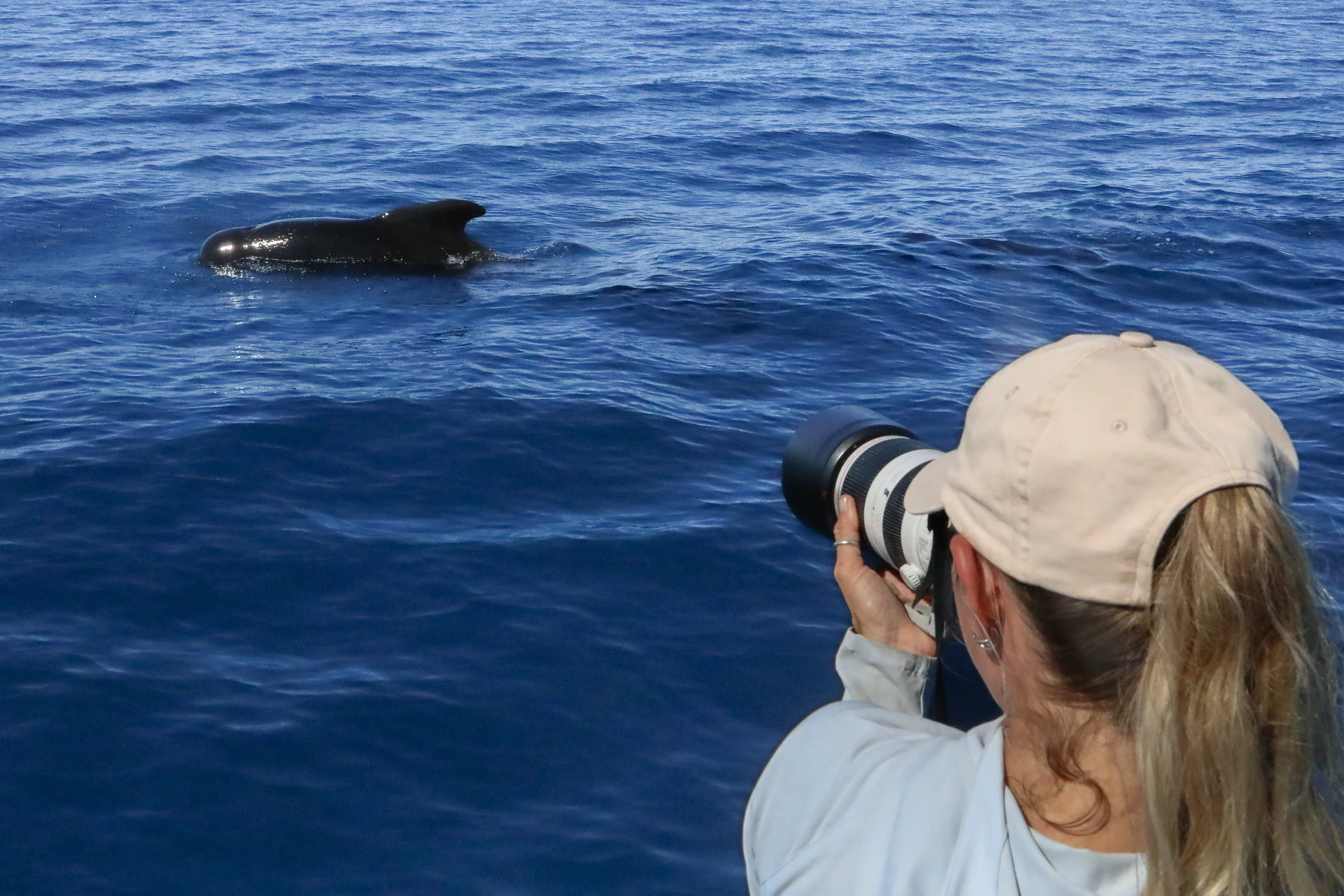Summer visitors in Loreto: The return of the Pilot Whales
Pod of Pilot Whales in Loreto, July 2025" photographed by Regina Domingo, our expedition leader
Loreto is not only a destination to see whales in winter; it’s a year-round haven for cetaceans, where visitors can encounter an extraordinary diversity of dolphins and whales in every season. From the iconic blue whales of winter to summer gatherings of pilot whales, bryde’s whales and sperm whales, and playful dolphins, Loreto truly celebrates marine wildlife all year long.
As summer arrives, the spotlight shifts to the spectacular return of short-finned pilot whales (Globicephala macrorhynchus), some of the Gulf of California’s most nomadic marine mammals.
July encounters with short-finned pilot whales in Loreto Bay National Park with Baja Adventures
During our long-distance expeditions during this July in Loreto Bay National Park, we were privileged to encounter remarkable gatherings of short-finned pilot whales (Globicephala macrorhynchus), showcasing their deep connection to the dynamic marine environment. These whales closely track the availability of squid, their primary prey, moving seamlessly between offshore deep waters and coastal zones as squid populations shift.
Short-Finned Pilot Whale by Regina Domingo
In particular, when squid spawn and aggregate nearer to shore during the cooler months, especially the summer spawning season, pilot whales follow, sometimes forming massive superpods.
During La Niña years in the Gulf of California, there is increased productivity and abundance of the giant squid (Dosidicus gigas), especially between the summer and autumn months (July to October), when squids reproduce in coastal areas. This rise in squid availability attracts a greater presence of odontocetes, such as dolphins and pilot whales, which rely heavily on squid as a primary food source, thus strengthening the marine ecological dynamics and food web in the region during these high-productivity periods.
Near Loreto, squid gather in large groups close to shore when they spawn, usually during summer. This event attracts their main predators, including short-finned pilot whales, which form large super-pods following these squid movements.
During our recent July expeditions in Loreto Bay National Park, we witnessed incredible super-pods of over 90 pilot whales, along with smaller groups of 50.
These pods consist of stable social subgroups of roughly 5 to 8 members, swimming in coordinated, cohesive formations that reflect their complex social bonds.
These sightings highlight the close connection between squid spawning cycles and the movements of key marine mammals in Baja California Sur, underscoring the importance of protecting these marine habitats.
Pilot Whales in Loreto, July 2025" photographed by Regina Domingo, our expedition leader
Scientific and ecological facts about the Short-finned Pilot whale
Taxonomy and description
Belongs to the dolphin family (Delphinidae), but is called a “whale” due to its robust size and appearance.
Recognized by its bulbous, rounded “melon” head, dark body, and short, curved flippers.
Range and habitat
Found throughout tropical and subtropical oceans worldwide, including the Pacific, Atlantic, and Indian Oceans.
Prefer deep offshore waters near the edges of continental shelves, submarine canyons, and regions rich in prey. They sometimes approach coastal areas but are mainly associated with waters over 600m deep.
Pilot Whale in Loreto, July 2025" photographed by Leopoldo Sanmiguel.
Social structure and behavior
Highly social; typically travel in cohesive pods of 15–50 animals, but groups of several hundred are seen on occasion.
Pods are often structured around close family ties, with matrilineal traits—elder females play key leadership roles.
“Alloparenting” behavior is well documented: non-maternal pod members help care for calves.
Complex social behaviors include coordinated diving, vocalizations, play (e.g., lobtailing, spyhopping), and sometimes mass strandings, the causes of which remain under study.
Pods use echolocation for navigation and hunting, producing a rich array of clicks and whistles.
Diet and foraging
Diet is dominated by squid, but octopus and fish (including mackerel, hake, and others) are also consumed where available.
Forage at substantial depths, regularly diving to 600–1,000m and capable of high-speed sprints at depth to catch swift-moving squid, earning them the nickname “cheetahs of the deep”.
Deep dives are primarily at night, following the vertical migrations of squid and other prey linked to the ocean’s “twilight zone”.
Reproductive biology and lifespan
Females mature around 9–12 years, males at 13–17 years.
Gestation lasts ~15 months; a single calf is usually born, and calves are nursed for 2–5 years, sometimes even longer.
Females give birth every 5–8 years (about four to five calves in a lifetime).
Remarkably, females experience menopause, with older (post-reproductive) females taking on important social roles in pod cohesion and calf caregiving.
Lifespan: females can live 60 years, males up to 45 years.
Pod of Pilot Whales in Loreto, July 2025" photographed by Regina Domingo, our expedition leader
Ecological role
As upper trophic level predators, short-finned pilot whales exert significant influence on pelagic food webs, particularly in regulating squid and some fish populations.
Their deep-diving and social foraging adapt them well to patchy, unpredictable oceanic environments, and their pod cohesion helps them locate and efficiently exploit food resources.
Threats and conservation
Threatened by incidental catch (bycatch) in fisheries, entanglement in gear, ship strikes, and targeted hunts in select regions.
Climate change is shifting their range, possibly increasing interactions (and hybridization) with the long-finned pilot whale.
Globally listed as “Least Concern” but protected under various treaties; in Mexico, they receive special legal protection.
Interspecific interactions: Whales and dolphins together
Interspecific Interactions of Short-Finned Pilot Whales and Bottlenose Dolphins in Loreto Bay — Observations by Regina Domingo
The interactions observed between pilot whales and dolphins are known as interspecific interactions. These behaviors are common when both species share the same habitat and prey, in this case, squid and fish, which brings them into frequent contact. Social play, cooperative swimming, and mutual curiosity are regularly observed, highlighting the complex and dynamic relationships in the marine environment. Sometimes these encounters may also have a mutualistic side, where both species benefit from shared intelligence or defense against predators, but more often they represent a social enrichment of their community structures.
The highly social nature of both species, each known for intelligence and intricate group communication, makes these gatherings lively and fascinating, for researchers, scientists and tourists.
Species insights
Globicephala macrorhynchus are robust, dark-colored whales identifiable by a prominent melon and a distinctive light-colored “saddle” mark behind their dorsal fin. They form complex social structures, with populations in the eastern Gulf of California estimated, based on photo-identification and capture-recapture models, to consist of over 2,200 individuals.
Baja Adventures in Loreto: Pioneers in regenerative tourism and responsible wildlife sightings
At Baja Adventures, we are proud to integrate scientific insights into immersive regenerative tourism experiences. Our long-distance marine expeditions in Loreto Bay and surrounding waters invite participants to explore these remote ecosystems, not only as observers but as active citizen scientists.
During these journeys, our team photographs species to build photo-ID catalogs and track individuals, collaborating closely with Nakawe Project and marine mammal researcher Mario A. Pardo and his team at CICESE (Centro de Investigación Científica y de Educación Superior de Ensenada). These data contribute to ongoing research on cetacean distribution, social behavior, and ecology in the Gulf of California.
Our regenerative tourism approach means travelers help create positive, lasting impacts: supporting scientific research, promoting local economic resilience, and fostering conservation awareness, helping ensure these magnificent whale populations thrive for future generations.
Regina Domingo, our wildlife expedition leader, taking pilot whales photo IDs.
Join the journey
Witnessing giant pilot whale gatherings, engaging with cutting-edge science, and participating in meaningful conservation, this is the Loreto regenerative tourism experience. From the biodiverse waters where whales chase their pray to dedicated researchers and local communities protecting these waters, your adventure here is truly a journey of discovery and regeneration.
Are you ready to dive deeper and make a difference, meeting some of the Gulf’s most fascinating cetaceans and supporting cutting-edge science with every adventure?







